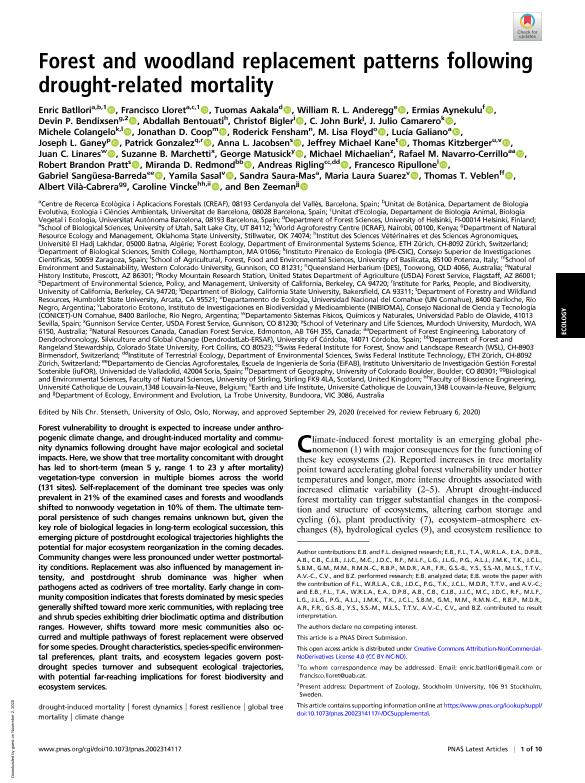Artículo
Forest and woodland replacement patterns following drought-related mortality
Batllori, Enric; Lloret, Francisco; Aakala, Tuomas; Anderegg, William R. L.; Aynekulu, Ermias; Bendixsen, Devin P.; Bentouati, Abdallah; Bigler, Christof; Burk, C. John; Camarero, J. Julio; Colangelo, Michele; Coop, Jonathan D.; Fensham, Roderick; Floyd, M. Lisa; Galiano, Lucía; Ganey, Joseph L.; Gonzalez, Patrick; Jacobsen, Anna L.; Kane, Jeffrey Michael; Kitzberger, Thomas ; Linares, Juan C.; Marchetti, Suzanne B.; Matusick, George; Michaelian, Michael; Navarro Cerrillo, Rafael M.; Pratt, Robert Brandon; Redmond, Miranda D.; Rigling, Andreas; Ripullone, Francesco; Sangüesa Barreda, Gabriel; Sasal, Yamila
; Linares, Juan C.; Marchetti, Suzanne B.; Matusick, George; Michaelian, Michael; Navarro Cerrillo, Rafael M.; Pratt, Robert Brandon; Redmond, Miranda D.; Rigling, Andreas; Ripullone, Francesco; Sangüesa Barreda, Gabriel; Sasal, Yamila ; Saura Mas, Sandra; Suarez, Maria Laura
; Saura Mas, Sandra; Suarez, Maria Laura ; Veblen, Thomas; Vilà Cabrera, Albert; Vincke, Caroline; Zeeman, Ben
; Veblen, Thomas; Vilà Cabrera, Albert; Vincke, Caroline; Zeeman, Ben
 ; Linares, Juan C.; Marchetti, Suzanne B.; Matusick, George; Michaelian, Michael; Navarro Cerrillo, Rafael M.; Pratt, Robert Brandon; Redmond, Miranda D.; Rigling, Andreas; Ripullone, Francesco; Sangüesa Barreda, Gabriel; Sasal, Yamila
; Linares, Juan C.; Marchetti, Suzanne B.; Matusick, George; Michaelian, Michael; Navarro Cerrillo, Rafael M.; Pratt, Robert Brandon; Redmond, Miranda D.; Rigling, Andreas; Ripullone, Francesco; Sangüesa Barreda, Gabriel; Sasal, Yamila ; Saura Mas, Sandra; Suarez, Maria Laura
; Saura Mas, Sandra; Suarez, Maria Laura ; Veblen, Thomas; Vilà Cabrera, Albert; Vincke, Caroline; Zeeman, Ben
; Veblen, Thomas; Vilà Cabrera, Albert; Vincke, Caroline; Zeeman, Ben
Fecha de publicación:
11/2020
Editorial:
National Academy of Sciences
Revista:
Proceedings of the National Academy of Sciences of The United States of America
ISSN:
0027-8424
Idioma:
Inglés
Tipo de recurso:
Artículo publicado
Clasificación temática:
Resumen
Forest vulnerability to drought is expected to increase under anthropogenic climate change, and drought-induced mortality and community dynamics following drought have major ecological and societal impacts. Here,we showthat tree mortality concomitant with drought has led to short-term (mean 5 y, range 1 to 23 y after mortality) vegetation-type conversion in multiple biomes across the world (131 sites). Self-replacement of the dominant tree species was only prevalent in 21% of the examined cases and forests and woodlands shifted to nonwoody vegetation in 10% of them. The ultimate temporal persistence of such changes remains unknown but, given the key role of biological legacies in long-term ecological succession, this emerging picture of postdrought ecological trajectories highlights the potential for major ecosystem reorganization in the coming decades. Community changes were less pronounced under wetter postmortality conditions. Replacement was also influenced by management intensity, and postdrought shrub dominance was higher when pathogens acted as codrivers of tree mortality. Early change in community composition indicates that forests dominated by mesic species generally shifted toward more xeric communities, with replacing tree and shrub species exhibiting drier bioclimatic optima and distribution ranges. However, shifts toward more mesic communities also occurred and multiple pathways of forest replacement were observed for some species. Drought characteristics, species-specific environmental preferences, plant traits, and ecosystem legacies govern postdrought species turnover and subsequent ecological trajectories, with potential far-reaching implications for forest biodiversity and ecosystem services.
Archivos asociados
Licencia
Identificadores
Colecciones
Articulos(INIBIOMA)
Articulos de INST. DE INVEST.EN BIODIVERSIDAD Y MEDIOAMBIENTE
Articulos de INST. DE INVEST.EN BIODIVERSIDAD Y MEDIOAMBIENTE
Citación
Batllori, Enric; Lloret, Francisco; Aakala, Tuomas; Anderegg, William R. L.; Aynekulu, Ermias; et al.; Forest and woodland replacement patterns following drought-related mortality; National Academy of Sciences; Proceedings of the National Academy of Sciences of The United States of America; 117; 47; 11-2020; 29720-29729
Compartir
Altmétricas



